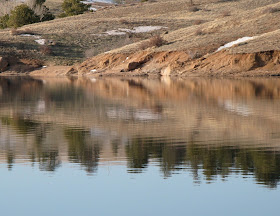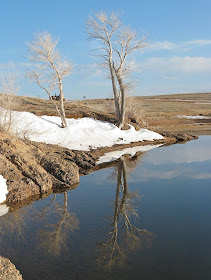 |
| An unusual landscape for southeast Wyoming ... |
 |
| ... and another version. |
Last Friday was a true spring day, justifying a trip to Curt Gowdy State Park for camping, evening hiking and moon-viewing. But several things didn’t go as expected. First, there still was too much snow on the ground to hike. Second, a bank of clouds over Nebraska obscured the moonrise. Third and most amazingly, there was virtually no wind! So I set my chair on a bank above Granite Reservoir and watched grebes, scaups and mergansers forage while an osprey fished. Sparky was intrigued by two geese grazing nearby. It was a lovely evening.
Suddenly I realized there were images on the surface of the water! (it's easy to overlook something not usually present). I grabbed the camera to capture this rare phenomenon.
reflection |riˈflek sh ən| (noun) 1 the throwing back by a body or surface of light, heat, or sound without absorbing it, e.g. an image seen in a mirror or shiny surface. 2 serious thought or consideration, e.g. an idea about something, esp. one that is written down or expressed (Oxford American Dictionaries)
Wavefronts of light were changing direction at the interface of air and water, returning into the medium from whence they came. Being a calm day, the reflections were specular (mirror-like), retaining images as well as energy and making for a happy photographer (from Wikipedia).
 |
| This landscape was disturbed a bit by a small boat carrying people fishing. |
 |
| Sparky birding (geese) against a backdrop of boat ripples. |
 |
| This specular sunset over Granite Reservoir seemed spectral as well. |
Before closing my consideration of reflections, I suppose I should add a “serious thought, esp. one that is written down”, i.e. definition 2 above. Here's one by John Shade, from Pale Fire (Vladimir Nabokov):
But this is dangerous. It’s too easy to see metaphor in nature. We could be drawn in and trapped by our reflections, just as Charles Kinbote’s analysis of Pale Fire led to his derangement. It’s safer to stick with the moment -- in this case, fortunately, a spring day. Birds sing, insects buzz, flowers are in bloom, people are smiling and laughing ... maybe just because we no longer have to wear so many clothes!
I was the smudge of ashen fluff -- and I
Lived on, flew on, in the reflected sky.
But this is dangerous. It’s too easy to see metaphor in nature. We could be drawn in and trapped by our reflections, just as Charles Kinbote’s analysis of Pale Fire led to his derangement. It’s safer to stick with the moment -- in this case, fortunately, a spring day. Birds sing, insects buzz, flowers are in bloom, people are smiling and laughing ... maybe just because we no longer have to wear so many clothes!


No comments:
Post a Comment